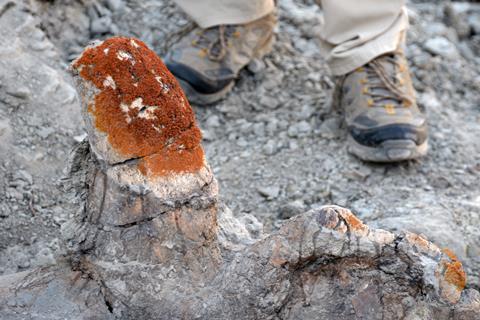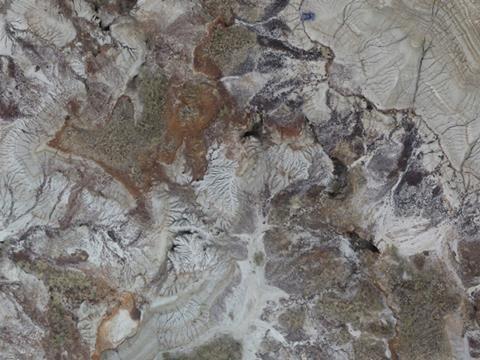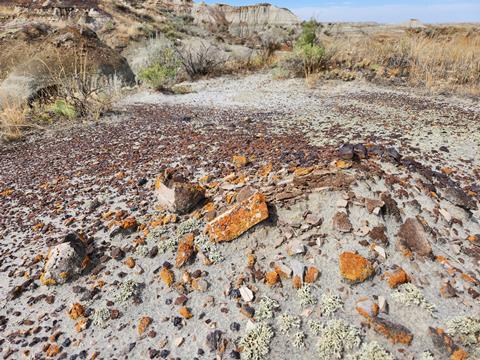Vibrant orange-coloured lichens are helping scientists discover dinosaur fossils in Canada, according to a new study published today in Current Biology.

An international team of palaeontologists and remote sensing scientists have made an exciting discovery at UNESCO World Heritage Site Dinosaur Provincial Park, in Alberta. They have found that certain lichen species preferentially colonise exposed dinosaur bones, creating distinctive spectral signatures that can be detected from 30 metres above ground using drones.
READ MORE: Microbial-induced pathologies in 80-million-year-old dinosaur bones
READ MORE: Deadly infectious bone disease wiped out long-necked dinosaurs in Brazil
Dr Brian Pickles, from the University of Reading (UK), and lead author of the paper, said: “This research highlights how modern organisms can help us to find ancient ones.
“It’s remarkable to consider that these lichens, essentially miniature ecosystems, are founded upon the remains of dinosaurs that died over 75 million years ago. Using drone technology to detect the spectral signatures of the lichens could potentially revolutionise how palaeontologists search for fossils.”
Lichen colonies
The team found that the two lichen species – Rusavskia elegans and Xanthomendoza trachyphylla – colonised as much as 50% of exposed fossil bones but less than 1% of surrounding rock fragments. This likely occurs because dinosaur bones provide the alkaline, calcareous, and porous substrates these lichens favour.
Dr Caleb Brown, from the Royal Tyrrell Museum of Palaeontology (Canada), said: “This pattern of lichen growing preferentially on fossil bone has been noted for decades, but never quantified until now. When first encountering high concentrations of exposed fossil bone like bonebeds, it is often the ‘meadow’ of orange lichen that is noticed first, not the bones themselves.”

Using Remotely Piloted Aircraft Systems (drones) with specialised sensors, the team successfully identified lichen-colonised fossils from aerial images with 2.5cm pixel resolution. The lichens exhibit distinct spectral properties, showing lower reflectance in blue wavelengths and higher reflectance in infrared regions.
The method can offer significant advantages for palaeontological prospecting, particularly in remote terrain where traditional ground surveys are challenging. The approach could accelerate fossil discovery while reducing field costs and environmental impact.
Orange pigmentation
The research builds on decades of anecdotal observations by palaeontologists. In 1980, palaeontologist Darren H. Tanke speculated that the orange pigmentation of the lichen on Centrosaurus bones might be detectable by satellites – a prediction that seems closer than ever now that they can be found using airborne drone technology.

Dr Derek Peddle, part of the remote sensing team from the University of Lethbridge (Canada), said: “This drone study lays the groundwork for mapping much larger areas using aircraft and satellites. The new lichen indicators we’ve developed will help us find fossils across vast landscapes. It’s exciting to combine our imaging technology with this international team’s expertise to advance dinosaur discovery through remote sensing of lichen.”
The team emphasises that the method works well in semi-arid environments like the Canadian Badlands, where the specific lichen species thrive and bones remain exposed long enough for colonisation. They intend to explore the broader extent of this association in their future work.
Topics
- Algae
- Brian Pickles
- Caleb Brown
- Centrosaurus
- Darren H. Tanke
- Derek Peddle
- dinosaurs
- drones
- Ecology & Evolution
- Fungi
- Healthy Land
- lichen
- Microbiological Methods
- palaeontology
- remote sensing
- Research News
- Royal Tyrrell Museum of Palaeontology
- Rusavskia elegans
- Soil & Plant Science
- UK & Rest of Europe
- UNESCO World Heritage Site Dinosaur Provincial Park
- University of Lethbridge
- University of Reading
- USA & Canada
- Xanthomendoza trachyphylla







No comments yet